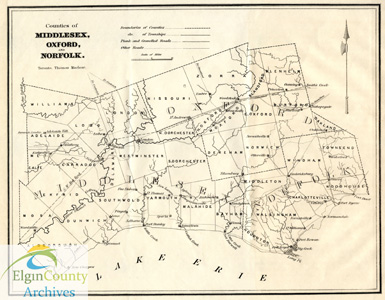Creation of a County
In 1792, Governor John Graves Simcoe divided the province into counties, placing modern day Elgin County in both the Western and Home Districts. At the time nineteen counties and three districts were created for the purpose of the upcoming election to elect representatives to sit at the provincial capital. Two additional  purposes for county creation included organization of militia and land registration.
purposes for county creation included organization of militia and land registration.
In 1800, the London District was established, and included the modern day counties of Middlesex, Oxford, Elgin, Huron, Perth and Bruce. In 1838, additional districts were created, decreasing the London District to only Middlesex and present day Elgin.
Changes in structure continued, and in 1850, the Division of Counties Act had counties replace districts as the basic unit of local government; changing the London District to the County of Middlesex.
But by 1851, the larger counties across the province were beginning to swell from population growth, and the system from half a century earlier was not providing adequate representation for the residents. In Elgin, meetings had started in 1846 for the purpose of discussion to separate from the County of Middlesex. The County of Elgin was established by an Act of the Legislature in August 1851.
Four times representatives from the townships in Elgin County sent signed petitions requesting separation from the London District and County of Middlesex. The fourth time it was accepted. By that point it was 1852 and provincially the shape and sizes of counties were changing with the Territorial Alterations Act. Although it allowed the newly named County of Elgin to separate from Middlesex, it laid conditions for that independence. Before Elgin could be a county in its own right, it must erect a courthouse and gaol. Until then, it would be part of the Provisional County of Middlesex and Elgin.
